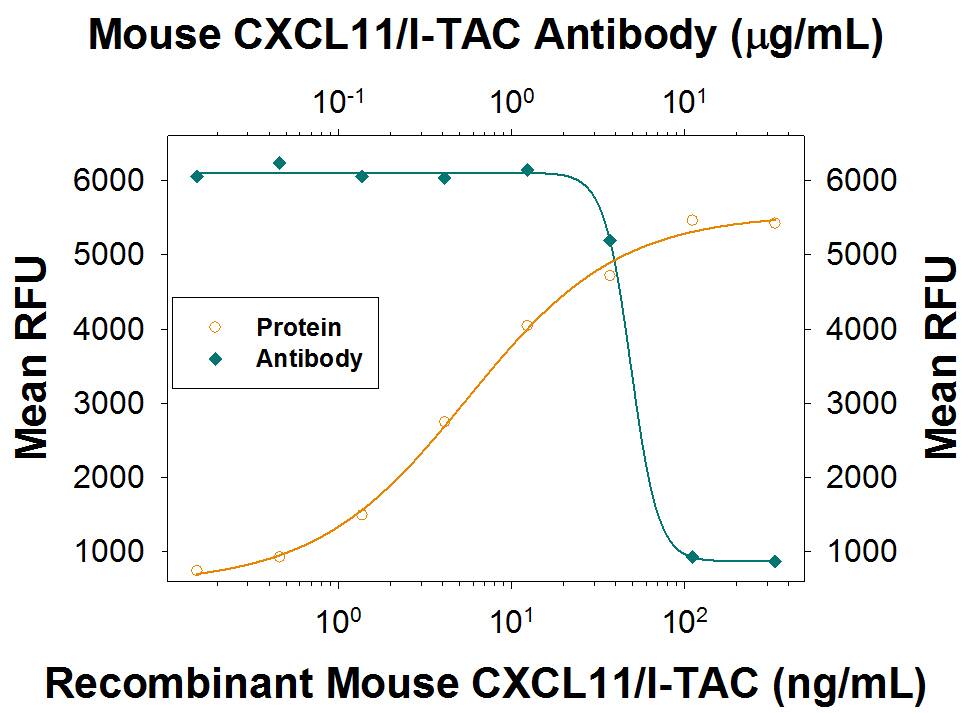Mouse CXCL11/I-TAC Antibody
R&D Systems, part of Bio-Techne | Catalog # AF572


Key Product Details
Species Reactivity
Validated:
Cited:
Applications
Validated:
Cited:
Label
Antibody Source
Product Specifications
Immunogen
Phe22-Met100
Accession # Q9JHH5
Specificity
Clonality
Host
Isotype
Endotoxin Level
Scientific Data Images for Mouse CXCL11/I-TAC Antibody
Chemotaxis Induced by CXCL11/I-TAC and Neutralization by Mouse CXCL11/I-TAC Antibody.
Recombinant Mouse CXCL11/I-TAC (Catalog # 572-MC) chemoattracts the BaF3 mouse pro-B cell line transfected with human CXCR3 in a dose-dependent manner (orange line). The amount of cells that migrated through to the lower chemotaxis chamber was measured by Resazurin (Catalog # AR002). Chemotaxis elicited by Recombinant Mouse CXCL11/ I-TAC (200 ng/mL) is neutralized (green line) by increasing concentrations of Goat Anti-Mouse CXCL11/I-TAC Antigen Affinity-purified Polyclonal Antibody (Catalog # AF572). The ND50 is typically 2-12 µg/mL.Applications for Mouse CXCL11/I-TAC Antibody
Western Blot
Sample: Recombinant Mouse CXCL11/I-TAC (Catalog # 572-MC)
Neutralization
Mouse CXCL11/I-TAC Sandwich Immunoassay
Formulation, Preparation, and Storage
Purification
Reconstitution
Formulation
Shipping
Stability & Storage
- 12 months from date of receipt, -20 to -70 °C as supplied.
- 1 month, 2 to 8 °C under sterile conditions after reconstitution.
- 6 months, -20 to -70 °C under sterile conditions after reconstitution.
Background: CXCL11/I-TAC
CXCL11 (also known as I-TAC, SCYB9B, H174, IP-9, and beta-R1) is a member within the non-ELR CXC chemokine subgroup and has been designated CXCL11. CXCL11, together with MIG and IP-10, constitute a subset of chemokines that are ligands for CXCR3, a chemokine receptor that is primarily expressed on activated Th1 cells and NK cells. The three chemokines were also reported to act as antagonists for CCR3, a chemokine receptor that is preferentially expressed on activated Th2 cells. Mouse CXCL11 cDNA encodes a 100 amino acid (aa) residue precursor protein with a putative 21 aa residue signal peptide that is cleaved to yield a 79 aa residue mature protein. Mature mouse and human CXCL11 share 71% aa sequence identity. Mouse CXCL11 also shares 36% and 29% aa sequence identity with mouse IP-10 (CRG-2) and mouse MIG, respectively. The gene for mouse CXCL11 has been mapped to chromosome 5, in close proximity to the IP-10 and MIG genes. Mouse CXCL11 is induced in multiple tissues during endoxemia, with the greatest expression in lung, heart, small intestine, and kidney. The endotoxemia-induced mouse CXCL11 expression is strongly attenuated by treatment with glucocorticoid.
References
- Widney, D.P. et al. (2000) J. Immunol. 164:6322.
- Meyer, M. et al. (2000) Cytogenet. Cell Genet. 88:278.
- Loetscher, P. et al. (2001) J. Biol. Chem. Manuscript M005652200.
Alternate Names
Gene Symbol
UniProt
Additional CXCL11/I-TAC Products
Product Documents for Mouse CXCL11/I-TAC Antibody
Product Specific Notices for Mouse CXCL11/I-TAC Antibody
For research use only